|
August
2022
Contents
Monthly Meeting
Upcoming Field Trips
Bird of the Month
Monthly Meeting
Report
Special Report
Field Trip Reports
AUGUST MEETING:
Thursday August 11, 2022, 7pm
Annual UCB Potluck
Dinner - Vivian Park, Provo Canyon
Join us for an evening of socializing with fellow bird lovers and nerds. We have
reserved the smaller pavilion at Vivian Park (Provo Canyon South Fork turnoff)
for our potluck dinner. We will provide tablecloths, plates, silverware, cups,
napkins, and water. Please bring a potluck item to share.
FIELD TRIPS:
(Please bring walkie talkies set to 5-0)
Friday,
August 5th, 2022 - 6:00 am
Mirror Lake Fieldtrip
(Summit and possibly Duchesne County)
Meet at 6:00 am at the Orem 800 N Harmon's grocery store to the west of the
gas pumps.
We will stop at Soapstone CG area. Then head up to Mirror Lake. Hoping for
the usual mountain birds like American Three-toed Woodpecker, Canada Jay,
and Clark's Nutcracker. Bring your National Park Pass or pay the fee. Bring
a lunch.
Saturday,
August 27th, 2022 - 7:30 am
Cascade Springs
(Wasatch County)
Meet at 7:30 am at the Orem 800 N
Harmon's grocery store to the west of the gas pumps. We will drive up the
Alpine Loop to Cascade Springs. You will need a National Park Pass or pay
the entrance fee. Bring a lunch. Hopefully we'll get our 22 species!
|
Upcoming Fieldtrips for 2022
|
|
|
|
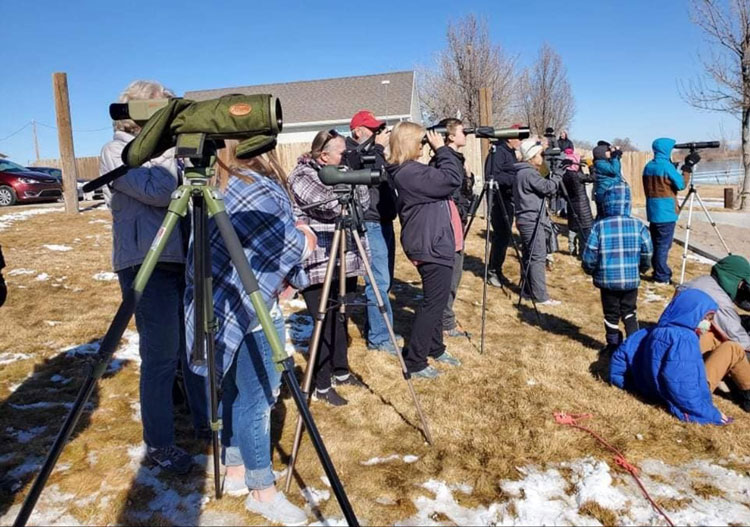 |
|
|
BIRD OF THE MONTH:
|
|
|
|
|
Greater Roadrunner
(Geococcyx
californianus)
Text by Jeremy Telford
Photos by Nichole Telford
Meep Meep! The Greater
Roadrunner is steeped in lore, from Acme explosions to sacredly shaped
footprints. It was also, until a week ago, as much my nemesis bird as I imagine
it still is to Wile E Coyote.
The Greater Roadrunner is part of the Cuckoo bird family that is more
famous for hanging out in clocks and imposing its eggs on unsuspecting parents.
Unlike some other Cuckoo species the Greater Roadrunner raises its own young.
The male gathers the sticks, twigs, and leafy matter and the female arranges it
into a nest either in a tree, bush, or on a cactus. If the male takes too long
to gather the materials or gets distracted the female emits a whining call
reminding him to get back to work. The resulting nest is typically 17 inches in
diameter and 8 inches thick, dipping to 4 inches thick in the center.
Roadrunners are voracious eaters. They eat, among other things, lizards,
insects, some fruit and seeds, centipedes, mice, and young ground squirrels.
They will also eat other birds like baby quail, sparrows, and they can even jump
vertically and snatch hummingbirds out of the air. They also go after venomous
prey that other predators avoid, like rattlesnakes, scorpions, and tarantulas.
They will even eat snakes that are too large for them to swallow, running around
with the tail sticking out of their mouth until their stomach’s have dissolved
enough for them to swallow the rest.
|
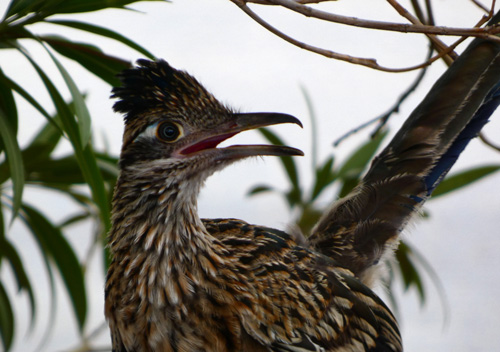
Photos taken in St. George, Utah
©Nichole Telford |
|
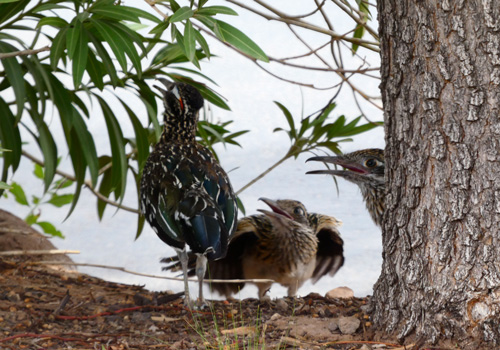
©Nichole Telford |
|
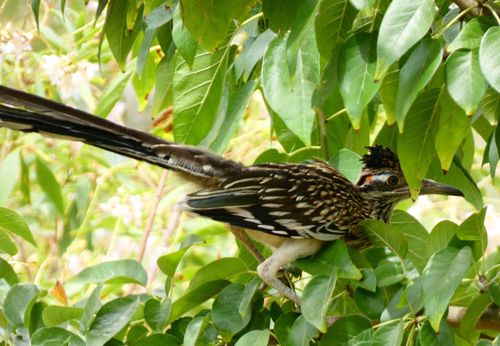
©Nichole Telford |
Though roadrunners prefer to run along the ground they can fly short distances.
Roadrunners can run a constant 15 miles per hour and can have short bursts
faster than that when pursuing prey maxing out at about 26 miles per hour.
Unfortunately a coyote has a top speed of 43 miles per
hour and that is without rockets and roller-skates.
Roadrunners are well adapted for their desert environments. Roadrunners
have a gland just in front of the eye from which they excrete salt, this uses
much less water than urinating for removing excess salts. They also get much of
their water from eating water rich prey like lizards. Also they have a
featherless patch on their chin called a gular which they can flutter to
dissipate heat.
Like some of the other birds in the cuckoo family, the Greater Roadrunner
is a zygodactyl bird. This is not a type of prehistoric reptile. Instead it
means that they have four toes and that two of its toes face forward and two
face backward. This gives them a unique ‘X’ shaped footprint. Pueblo tribes
thought this shape sacred and that it would ward off evil spirits. Since the x
is the same shape from any direction the evil spirits wouldn’t know what
direction to travel to try and follow.
There is a legend about the rivalry between the rattlesnake and the
roadrunner among the Tejas. The rattlesnake was the official messenger of the
Great Spirit bringing messages to wise men of the native tribes. No animal or
person dared stand in its way due to its venomous nature. The roadrunner knew it
could run much faster than the snake. One day it overheard the Great Spirit
giving the rattlesnake a message. Seizing its chance the roadrunner rushed
ahead, delivered the message, and enlisted the aid of the wise native to become
a messenger permanently. The Great Spirit was both impressed and annoyed.
Impressed at the speed of the delivery, but annoyed that the roadrunner would
eavesdrop on a private conversation. In the end the Great Spirit used the
roadrunner but only for unimportant messages. The rattlesnake was still angry.
It sought out the roadrunner’s nest and ate its young. When the roadrunner
discovered what had happened it sought out the snake’s young and returned the
favor. From then on the bird nested off of the ground and has always looked both
ways when returning home to make sure it had not been followed.
It is easy to see how this lively bird could spark the imagination of so
many cultures and be the source for many stories and legends. It was a pleasure
to see not one, but three and check it onto my life list last month. Seriously,
I may have teared up a little. And although it is no longer my nemesis bird it
is still on my short list of birds to always look for when I am in their habitat
and probably will be for very long time.
https://www.allaboutbirds.org/guide/Greater_Roadrunner
https://www.audubon.org/field-guide/bird/greater-roadrunner
http://mythfolklore.blogspot.com/2014/04/tejas-legends-paisano-hater-of.html
[See
past Bird of the Month articles]
|
|
|
|
|
Monthly Meeting Report
by Keeli Marvel
Eight birders met for our bird
walk/July meeting on Tuesday and we had a great walk along the west end of the
North Shore Utah Lake trail. Highlights from our walk included seeing newly
fledge great horned owlets, western wood-pewees and warbling vireo, Caspian
terns, the resident marmots, and getting great looks at a pair of Eastern
Kingbirds that have returned to nest along the trail. We ended up with around 26
species for the evening. I didn’t get any pics of the group, but it was a
beautiful evening and thanks to everyone who joined us! |
|
|
|
|
New Species for Utah
by Milt Moody
|
|
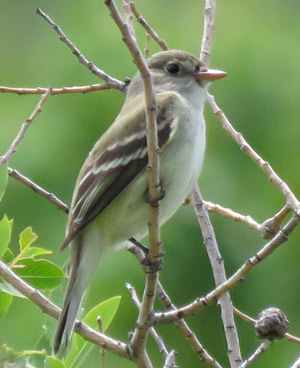
Alder Flycatcher
by Bryant Olsen
eBird Photo
|
On June 21st, Adam Zahm
discovered an Alder Flycather at Little Dell Reservoir. This
species had never been officially documented in the state before, although there
was a very well-written report in September 2016 at the Salt Lake International
Center that unfortunately didn't include an audio recording. Because the
Alder Flycatcher is part of the Empidonax group of flycatchers, which look very
similar to each other, an audio recording is often needed to confirmation the ID.
This latest
sighting was
thoroughly reviewed but easily accepted by the
Records Committee since
there were at least seven audio recordings, two official sight records, and
numerous photos, from many observers over a three-day period. Overwhelming
evidence!
So we have a new species on our
Utah State Checklist. This makes 462 species on the checklist
itself and with the seven species that are on the
Provisional Species List, that makes 469 species that have sight
records that have been accepted for Utah.
The Alder Flycatcher joints a list of
First State Records that has grown by 20 birds in
the last 10 years and an astounding 50 species in the last 20 years.. This
may be due to more birders, more capable cameras and better access to audio recording equipment.
So judging from the 30 species on the
Unverified Species List, which have records submitted but none accepted,
we can probably expect many more to come in the future.
|
|
Field Trip Reports
|
Owling Trip - Nebo Loop
28 July 2022
by Suzi Holt
|
|
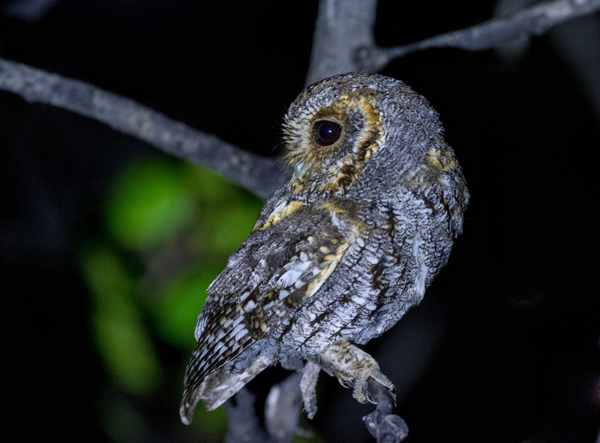
Flammulated Owl
by Jeff Cooper
©Jeff Cooper |
On Thursday July
28th 16 birders met at Walmart in Payson and headed south to Nephi to start
a evening of owling. We started on the Juab side of the Nebo Scenic Loop.
Our first birds were Common Nighthawk and Western Wood Pewee.
We then had a Great Horned Owl fly over the road in front of us and
land in a tree. It was calling and put on a beautiful show. Next stop was
along Salt Creek, we had a couple Flammulated Owls calling. But we
never did get a look at them, but it sure is fun to hear them. Although some
of the calls will send chills down your spine in the dark. We worked our way
up the loop and found a couple more Flammies calling. We could also hear a
Northern Saw Whet Owl We were all so excited to finally get to see
it!! We also saw a huge ugly spider. Yikes!
Up the road we went, we stopped and heard more Flammulated Owls, same
story we never got a look.
Our last stop was Beer Can Flats we tried for Common Poorwill with no luck
but did have 3 Western Screech Owls calling. It was a fun night! We
finished a little after 1:00 am. I'm sure everyone slept in on Friday.
Happy birders! |
|
|
|
|
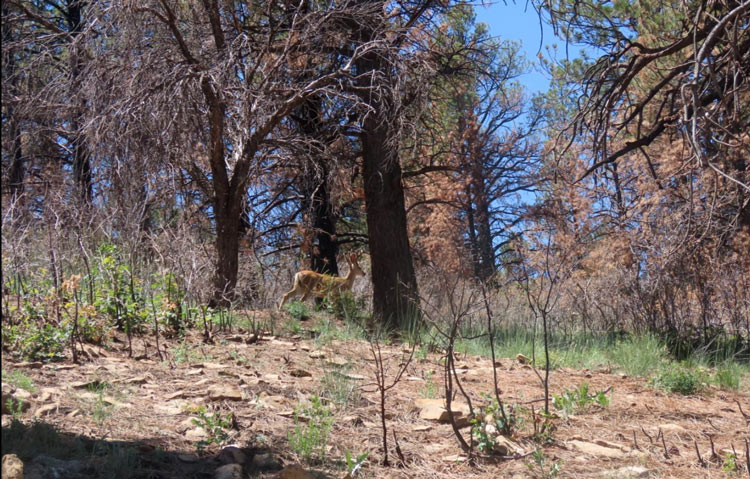
Mule Deer-Price Recreation Area |
Emery and Carbon County Fieldtrip
8 July 2022
by Suzi Holt
|
|
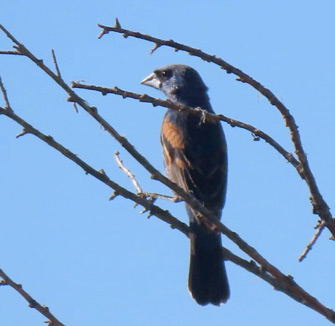
Blue Grosbeak |
We got up early and
headed up highway 6 to Emery and Carbon County.
Our first spot was Desert Lake in Emery County. We saw 27 species there! It
was really dry but we managed to find some great birds. Our best was
definitely a pair of Blue Grosbeaks! We also saw lots of Canada Geese,
Vesper and Lark Sparrows, a lone American Avocet, Long-billed Curlew,
Western Kingbird, Common Raven, and a Northern Mockingbird. Other birds to
note were Eurasion-collard Doves, Western Meadowlark Red-winged and a
Yellow-headed Blackbird, Swainson's Hawk, American Robin, Northern Harrier,
Killdeer, Cliff Swallow, a few Common Yellowthroats, a Great Blue Heron,
down the road we saw a Horned Lark, a couple Mallards, a pair of
Ring-necked
Pheasants, a Rock Wren, Turkey Vulture, Black-billed Magpie and
Black-throatedSparrow.
|
|
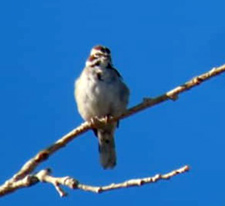
Lark Sparrow |
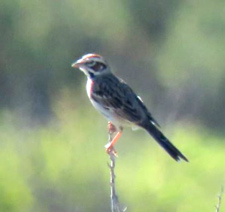
Lark Sparrow |
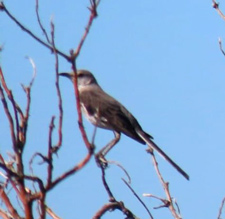
Northern Mockingbird- |
|
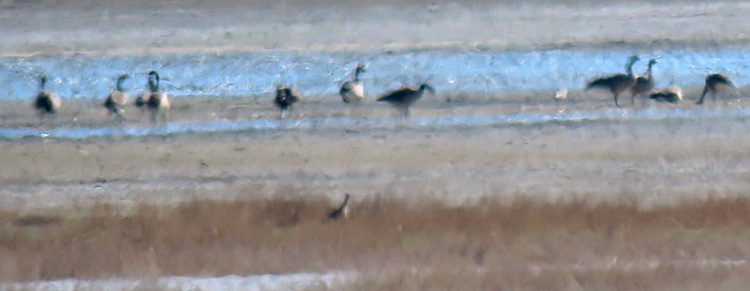
Long-billed Curlew and Canada
Goose-Desert Lake
|
|
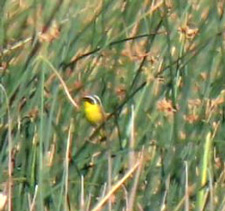
Common Yellowthroat-Desert Lake |
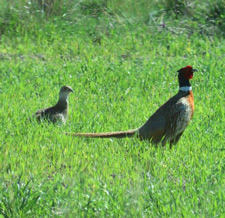
Ring-necked Pheasants |
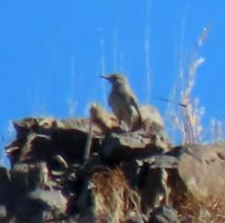
Rock Wren
|
|
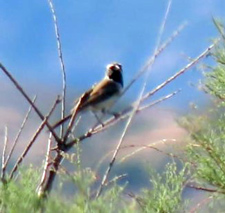
Black-throated Sparrow |
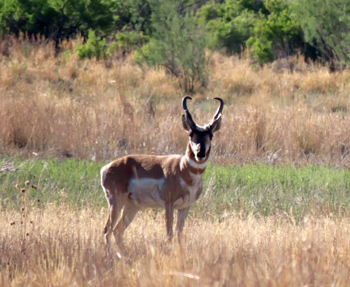
Cantaloupe |
|
|
Now off to Carbon County.
We stopped at the gas station and saw a House Sparrow and Rock Pigeons. We
also saw a couple Violet Green Swallows at Gigliotti Pond. It was pretty
quiet so we headed up the mountain to the Price
Recreation Area. After last year's fire it broke my heart to see
all the burn. It was quiet up there too but we managed 25 species!
|
|
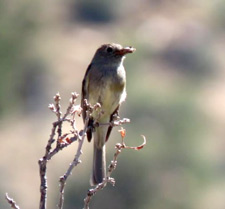
Dusky Flycatcher
|
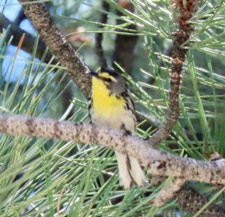
Grace's Warbler
|
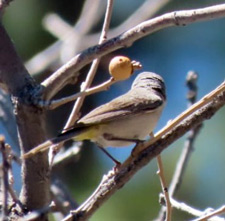
Virginia's Warbler
|
|
|
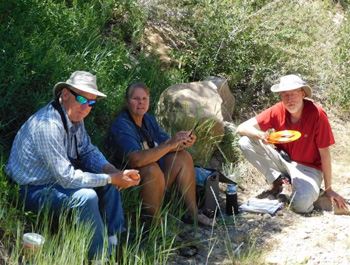
Chris Lackenbucher, from Michigan , joined the group.
Photo by Steve Van Winkle |
On the way up we ran into a "birdographerhiker" from Michigan. He hopped in
the car with us crazies and birded with us for the afternoon. We saw
Blue-gray Gnatcatchers and a Dusky Flycatcher and a Red-tailed Hawk
on the
road up. At the campground we searched for the American Three-toed
Woodpecker to no avail. But we did have lots of other good birds. My
favorite is always the Grace's Warbler. Oh and hearing the Red Crossbill! We
also had lots of Spotted and Green-tailed Towhees, Ruby-crowned Kinglet,
Mountain Chickadee, Swainson's and Hermit Thrush, Virginia's Warbler,
American Robin, Plumbeous Vireo, Western Tanager, Western Kingbird, Hairy
Woodpecker, Chipping Sparrow, Pine Siskin. On our way back down we saw a
Warbling Vireo, Black-throated Gray Warbler, Woodhouse's Scrub Jay,
Black-headed Grosbeak, Mourning Dove, a Golden Eagle and Downy Woodpecker!!
|
|
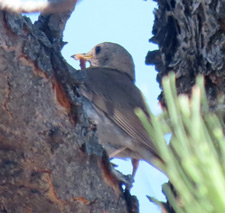
Hermit Thrush |
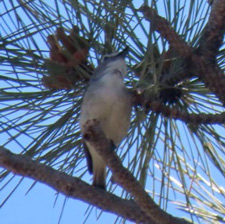
Plumbeous Vireo |
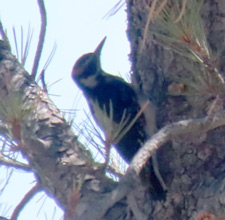
Hairy Woodpecker |
| I felt bad I had to change the trip from Saturday to Friday. We only had 5
well 6 with Chris from Michigan, but it's always a fun time!
See ya all next
time.... |
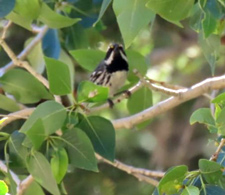
Black-throated Gray Warbler
|
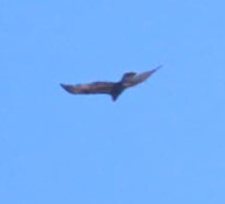
Golden Eagle
|
|
|
|
Utah County Birders website
Utah County Birders Board Members
If you'd like to write an
article for the news newsletter...
send it to:
ucbirders@utahbirds.org
|
|
|
|
|